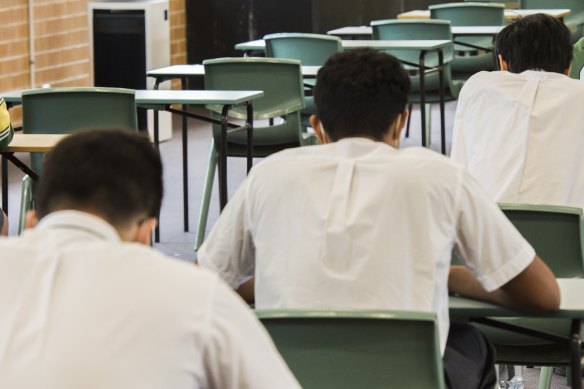By Jordan Baker
Powerful university chiefs have ordered a review of International Baccalaureate results amid concerns that overly generous marking gave private schools an ATAR advantage after more than one in 20 IB students in NSW achieved 99.95 last year.
The surprising results have upset some school principals, parents and many in the broader education sector, who worry that inflated IB results could undermine the fairness of the HSC. Students with top ranks gain access to the most sought-after degrees in the state, such as law and medicine.

Students sit the Higher School Certificate last year.Credit:
The IB is offered in only some NSW private schools and is often part of the school’s marketing. It is not offered in public schools. Former HSC boss Tom Alegounarias said the most disadvantaged students suffered when “financial privilege” played a role in school-leaving credentials.
“There is no clearer ethical responsibility than to treat all students equally, and our universities are failing at it here,” he said.
But a spokeswoman for the IB said the organisation’s priority was to ensure students were not disadvantaged when applying for university during the pandemic.
Last year fewer than 600 NSW students sat the IB diploma, but at least 41 of them achieved the highest possible university entrance rank, compared with just 35 across the whole country the year before. Of 55,000 HSC students eligible for ATARs, only 48 achieved the same 99.95.
Twelve of the IB top achievers were from a single, non-selective girls’ school, and nine were from a non-selective boys’ school. Just five students from the highly selective James Ruse Agricultural High – the state’s top school for the past 26 years – achieved the same rank by doing the HSC.
The NSW Vice Chancellors’ Committee has asked the University Admissions Centre (UAC) – which it owns – to investigate the sharp rise in so-called perfect scores, a number of sources told the Herald on the condition of anonymity because they were not authorised to speak publicly. IB students’ ranks will not be affected.
The university chiefs are concerned about so-called grade inflation, which involves awarding higher marks than in the past for the same standard of work.
“As we saw with the HSC, changes were made to IB assessment procedures in consideration of the pandemic and this may have impacted on their scores,” the UAC’s head of marketing and engagement, Kim Paino, said. “But we will continue to monitor IB results to ensure that our conversion remains fair.”
The IB was generous in its marking of Northern Hemisphere exams last May, giving out quadruple the number of top marks as it had on average over the previous four years.
The number of top IB ranks does not affect the number of top ranks given to HSC students, but it does secure them spots in the state’s most sought-after university courses at the expense of lower-ranked HSC students.
The issue of how to equate IB marks with the ATAR has long been a point of friction, partly because of the lack of information given to Australian authorities, and partly because many in the education sector feel it gives some private school students an unfair advantage.
The IB only gives Australian authorities a mark out of 45, and not the students’ raw marks. UAC equates a 45 with an ATAR of 99.95. In contrast, UAC has access to all HSC data and analyses it significantly, adjusting according to subject difficulty before giving students a mark out of 500 and ranking them.
UAC was supposed to get more detailed data from the IB for 2022 university admissions so that it could better differentiate ranks, but the IB decided to delay that until 2023, saying students had already faced too much disruption during the pandemic.
Many of the private principals whose schools do not offer the IB are worried about this year’s results.
“It’s causing consternation,” said one, who did not want to be named. “I think there will be some schools who think, ‘if you can get 12 kids to get 99.95, why would we be doing the HSC?’ I think it’s a real threat to the reputation of the future of the HSC if that’s going to continue.”
Ms Paino said UAC was guided by fairness and accuracy when assessing ATAR equivalents for international qualifications, which include British A-levels and American SATs. “It’s not always easy because of the very fine-grained nature of university selection ranks,” she said.
“We also regularly review our conversions to ensure they are providing a fair comparison with local students.”
The chair of IB Schools Australasia, David Boardman, said the conversion from IB scores to ATAR equivalents was managed by Australian authorities and the association had no input. “The association wishes that all students are treated equitably regardless of whether they study an IB program or an alternative,” he said.
The IB Organisation has been honest about easing students through the pandemic. “The IB has taken the pandemic’s global disruption to education into account when determining grades for this year,” a spokeswoman said. “The IB’s main priority has been to ensure students are not disadvantaged by the pandemic, including their applications to university and higher education.”
There has been significant grade inflation in Britain’s A-levels since the pandemic began, with the proportion of students there getting top grades rising by almost 75 per cent. The IB is widely used in Britain, where students with both credentials compete for university entry.
Between 2017 and 2019, between 260 and 275 students achieved top scores of 45 in the May session of the IB. In 2020, that climbed to 341, and in 2021 it soared to 1187. There were fewer candidates in 2021 than in 2020.
The Morning Edition newsletter is our guide to the day’s most important and interesting stories, analysis and insights. Sign up here.